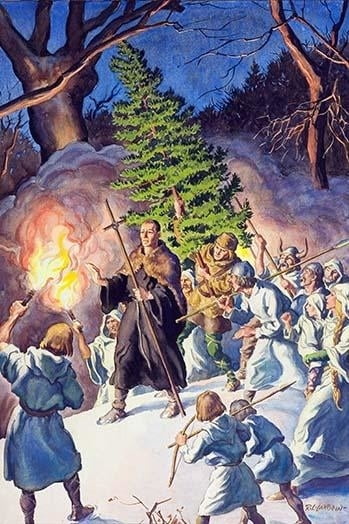
When talking about astrology, the first holiday that comes to mind is Halloween. After that, no holiday in western culture really resonates with society in making a connection to astrology. However, everyone’s favorite holiday season actually has strong ties with astrological events, and all that correlates with it.
This can be shown in the historical origins of the holiday, and how different cultures and religions celebrate and honor the event.
Photo Source (Pagan Yule Tradition)

Origins:
As mentioned– many times throughout this blog– Celtic faith, Paganism, and astrology are almost always connected. A typical western Christmas includes elements and events such as Christmas trees, yuletide, and giving gifts to friends and loved ones. For generations before the Christian church adopted this holiday as their own, all these celebratory acts were fostered by the Pagan faith.
Christmas aligns with the winter solstice. There are two solstices a year, a previous blog post having been dedicated to the summer solstice. The winter solstice is the longest day of the year and historically celebrated by pagans around December 22nd. This documented celebration is notable for its worship of the evergreen tree. This tree was seen as important, considering it was the only tree that was green all throughout the winter. The act of decorating the tree with ornaments was evolved as Roman tradition took hold during later years. Similarly, the Roman Pagans celebrated the Saturnalia Festival through December 17th to the 23rd. The purpose of this celebration being to honor the ancient gods, thus directly associating itself with the twelve zodiac signs. This festival consisted of many outdated acts, such as sacrifices of pigs and communal orgies, yet it also featured the acts of giving gifts and performing and singing on streets, going door to door. However, around 45 BCE, Julius Caesar circulated the use of a new calendar. This changed the date of all pagan holidays during the winter solstice to December 25th. Overall, the winter solstice traditions reflect onto what is considered to be modern Christmas celebrations.
Winter Solstice Traditions:

There are many holiday traditions that reflect honoring the winters solstice and the new beginnings that are associated with this astrological event. One example of this is handmade decorations. These can be anything from creating garlands for your house to hanging up paper dolls and snowflakes. Another common practice is making yule logs. Whether this is being used for the Christan purpose of advent, decoration, or warmth, the name gives way to its solstice origins. Another, very identifiable, tradition is the act of a Christmas feast. This meal typical is a gathering of family and close friends and eating seasonal foods. Historically this meal included chicken, ham, root vegetables, and desserts. These foods are still associated with the holiday season and very common to eat on or around Christmas.
Overall, at his point in time, within modern society, most people choose not to indulge in the original astrological significance of this holiday, but rather unknowingly participate in traditions with astrological origins.